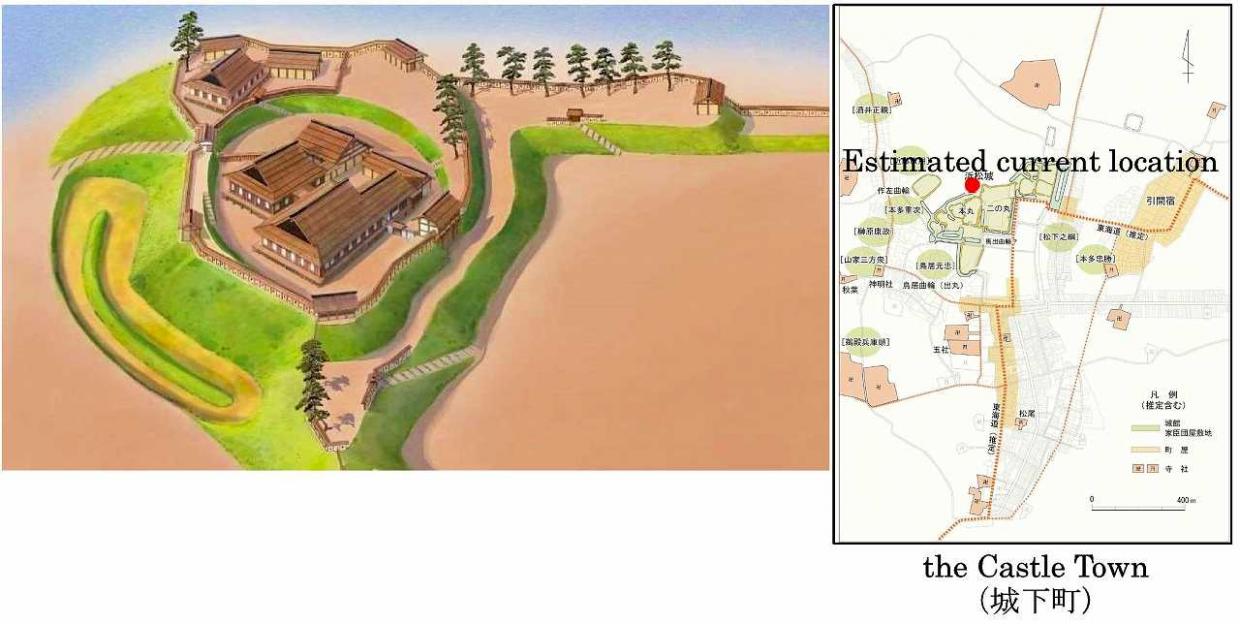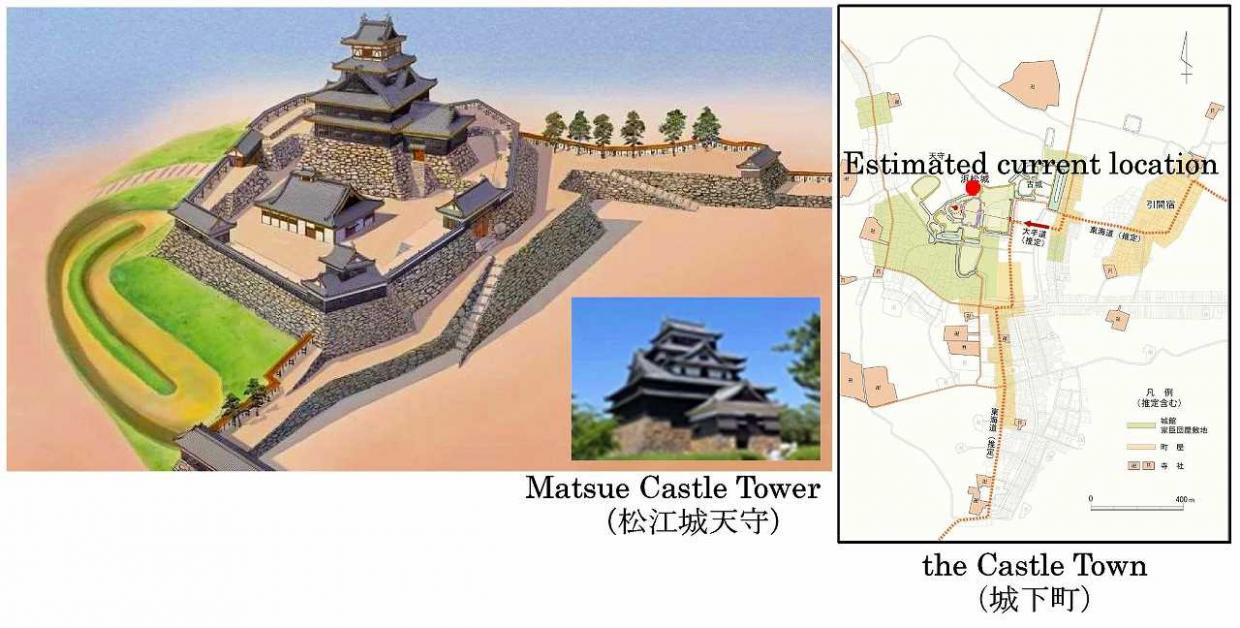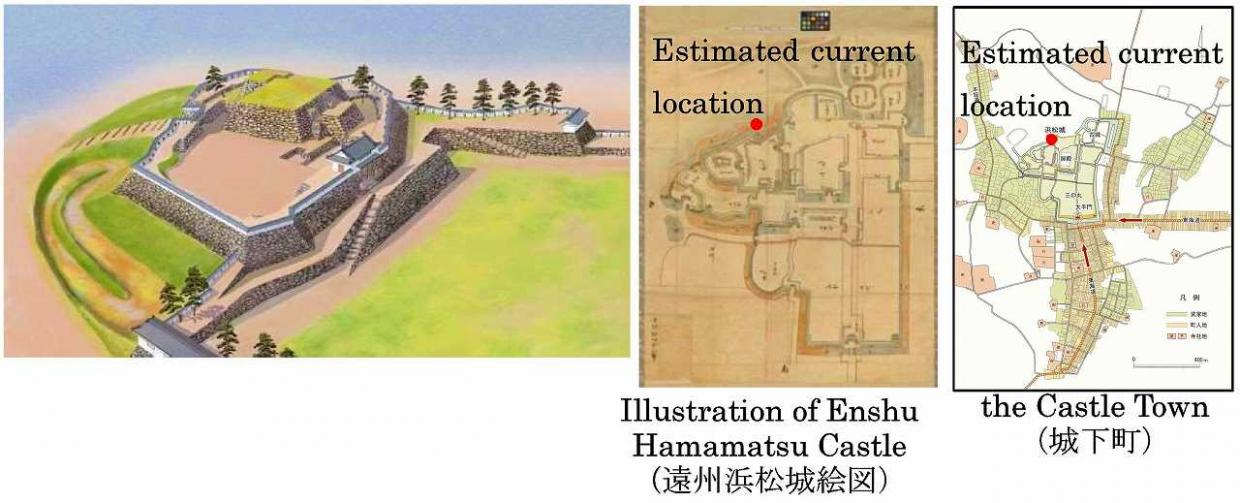緊急情報
ここから本文です。
更新日:2023年12月19日
The History of Hamamatsu Castle
Central Area of Hamamatsu Castle and the Castle Town Uunder TOKUGAWA Ieyasu
Research and Supervision by Hiroshima University Professor Emeritus MIURA Masayuki
Illustrations by ITAGAKI Makoto

In 1570, TOKUGAWA Ieyasu moved his base from Okazaki Castle to Hikuma Castle and began construction to expand the castle, changing its name from Hikuma Castle to Hamamatsu Castle. Due to the expansion, the central area of Hamamatsu Castle was moved to its current location.
It can be said that TOKUGAWA Ieyasu built Hamamatsu Castle from scratch due to the large-scale constructions he made, especially around the year 1578.
Ieyasu used Hamamatsu Castle as a base until he moved to Sunpu Castle in 1586.
Taking advantage of the terrain at the edge of the Mikatahara plateau, Hamamatsu Castle is thought to have stretched out eastwards and westwards.
To the north, it stretched out towards the wetlands that were suitable for defense.
The scope of Ieyasu’s expansion of Hamamatsu castle covered the castle tower bailey, main bailey, second bailey, Nishi-hajo bailey, Shimizu bailey, Sakuza bailey and the outer fort.
Afterwards, Hamamatsu Castle that was built by Ieyasu went through renovations under the TOYOTOMI family retainer, HORIO Yoshiharu, who was the new castle lord.
Large areas of the castle were buried underground but the size and positions of the baileys remained the same.
During Ieyasu’s time, the stone walls or castle tower were not yet built.
Instead, the bailey was enclosed by earthen walls and contained wooden houses with wooden shingle roofs.
Central Area of Hamamatsu Castle Under HORIO Yoshiharu and the Castle Town

Under orders from TOYOTOMI Hideyoshi, TOKUGAWA Ieyasu moved to Edo Castle in 1590.
The territories governed by Ieyasu up until then were distributed to Hideyoshi’s retainers.
Okazaki Castle was given to TANAKA Yoshimasa, Sunpu Castle to NAKAMURA Kazuuji, Kakegawa Castle to YAMAUCHI Kazutoyo and Hamamatsu Castle to HORIO Yoshiharu.
Yoshiharu built the high stone walls, watchtowers with tiled roofing, the castle gate, and the main castle tower.
Judging from the position of the castle tower and gate, it appears that Hamamatsu Castle was built to face the east.
We are able to learn about the renovations made by Yoshiharu through the stone walls that are still standing today and the results of our excavations.
The excavations tell us that the grounds of the castle tower bailey were lower than it is today, and there was a surrounding stone fort 3.2m in length.
It is possible that there was a watchtower with a tiled roof in the southeast corner of the castle tower bailey.
The current castle tower built in 1958 has a 3-floor structure but it was deliberately made smaller compared to the size of its base.
It is thought that the castle tower built by Yoshiharu had 5 floors and a basement based on the scale of the tower platform and Matsue castle which was also built by Yoshiharu but completed after his death.
It is thought that watchtowers were attached to the front and back of the castle tower in a composite style.
Central Area of Hamamatsu Castle After Abandonment and Illustration of Enshu Hamamatsu Castle・the Castle Town

In 1600, TOKUGAWA Ieyasu emerged victorious in the battle of Sekigahara against TOYOTOMI clan loyalists, and installed TOKUGAWA house vassals at important locations along the Tokaido road, including Hamamatsu Castle.
As a base for governing the local area, Hamamatsu Castle’s existing buildings were renovated and repaired with the third bailey being expanded.
Old records and illustrations show what Hamamatsu Castle looked like in the Edo period.
As the illustrations do not show the castle tower and the watchtowers in the castle tower bailey, they are thought to have been demolished in the early Edo period.
The castle tower bailey was only surrounded by an earthen wall with only the front (Tenshumon) and back (Uzumimon) gates still standing.
The front gate was maintained throughout the Edo period at the highest point in the area as the watchtower gate.
There were several structures in the main bailey such as the Kuroganemon which acted as the front gate, the Tamon watchtower to the north, the Hishi watchtower in the southeast corner, and the Fujimi watchtower located in the northern side of the bailey.
Between 1872 and 1873, the buildings and land belonging to Hamamatsu Castle were sold and all of the buildings were lost during this period.
お問い合わせ
より良いウェブサイトにするためにみなさまのご意見をお聞かせください